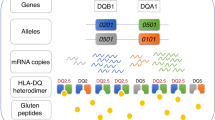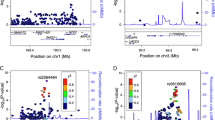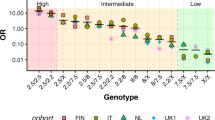Abstract
IgA deficiency (IgAD) and common variable immunodeficiency (CVID) often co-occur in families, associating with chronic inflammatory diseases such as celiac disease (CD). ICOS (inducible co-stimulator) and CTLA4 (cytotoxic T-lymphocyte-associated protein-4) may be important in both disorders, as ICOS is necessary for Ig class-switching and CTLA4 negatively regulates T-cell activation. Linkage and association of CD with CTLA4-ICOS is well documented, we thus aimed to further pinpoint CD susceptibility by haplotype-tagging analysis. We genotyped 663 CD families from Finland and Hungary, 575 additional CD patients from Finland, Hungary and Italy; 275 Swedish and Finnish IgAD individuals and 87 CVID individuals for 14–18 genetic markers in CTLA4-ICOS. Association was found between CTLA4-ICOS and both IgAD (P=0.0015) and CVID (P=0.0064). We confirmed linkage of CTLA4-ICOS with CD (LOD 2.38, P=0.0005) and found association of CTLA4-ICOS with CD (P=0.0009). Meta-analysis of the IgAD, CVID and CD materials revealed intergenic association (P=0.0005). Disease-associated markers were associated with lower ICOS and higher CTLA4 expression, indicating that the risk haplotypes contain functional variants. In summary, we identified a novel shared risk locus for IgAD, CVID and CD, the first report of association between CTLA4-ICOS and IgAD. Association between CD and CTLA4-ICOS was also confirmed in a large European data set.
This is a preview of subscription content, access via your institution
Access options
Subscribe to this journal
Receive 6 digital issues and online access to articles
$119.00 per year
only $19.83 per issue
Buy this article
- Purchase on Springer Link
- Instant access to full article PDF
Prices may be subject to local taxes which are calculated during checkout


Similar content being viewed by others
References
Collin P, Maki M, Keyrilainen O, Hallstrom O, Reunala T, Pasternack A . Selective IgA deficiency and coeliac disease. Scand J Gastroenterol 1992; 27: 367–371.
Koskinen S . Long-term follow-up of health in blood donors with primary selective IgA deficiency. J Clin Immunol 1996; 16: 165–170.
Latiff AH, Kerr MA . The clinical significance of immunoglobulin A deficiency. Ann Clin Biochem 2007; 44: 131–139.
Hammarstrom L, Vorechovsky I, Webster D . Selective IgA deficiency (SIgAD) and common variable immunodeficiency (CVID). Clin Exp Immunol 2000; 120: 225–231.
Aghamohammadi A, Mohammadi J, Parvaneh N, Rezaei N, Moin M, Espanol T et al. Progression of selective IgA deficiency to common variable immunodeficiency. Int Arch Allergy Immunol 2008; 147: 87–92.
Vorechovsky I, Zetterquist H, Paganelli R, Koskinen S, Webster AD, Bjorkander J et al. Family and linkage study of selective IgA deficiency and common variable immunodeficiency. Clin Immunol Immunopathol 1995; 77: 185–192.
Koistinen J . Familial clustering of selective IgA deficiency. Vox Sang 1976; 30: 181–190.
Gerbase-Delima M, Pinto LC, Grumach A, Carneiro-Sampaio MM . HLA antigens and haplotypes in IgA-deficient Brazilian paediatric patients. Eur J Immunogenet 1998; 25: 281–285.
Schroeder Jr HW, Zhu ZB, March RE, Campbell RD, Berney SM, Nedospasov SA et al. Susceptibility locus for IgA deficiency and common variable immunodeficiency in the HLA-DR3, -B8, -A1 haplotypes. Mol Med 1998; 4: 72–86.
Vorechovsky I, Webster AD, Plebani A, Hammarstrom L . Genetic linkage of IgA deficiency to the major histocompatibility complex: evidence for allele segregation distortion, parent-of-origin penetrance differences, and the role of anti-IgA antibodies in disease predisposition. Am J Hum Genet 1999; 64: 1096–1109.
Czyzewska-Buczynska A, Majkowska-Skrobek G, Jankowski A . Association of HLA-*08:DRB1*03 with immunoglobulin A-deficiency. Indian J Pediatr 2007; 74: 1021–1024.
Price P, Witt C, Allcock R, Sayer D, Garlepp M, Kok CC et al. The genetic basis for the association of the 8.1 ancestral haplotype (A1, B8, DR3) with multiple immunopathological diseases. Immunol Rev 1999; 167: 257–274.
Gough SC, Walker LS, Sansom DM . CTLA4 gene polymorphism and autoimmunity. Immunol Rev 2005; 204: 102–115.
Popat S, Hearle N, Hogberg L, Braegger CP, O'Donoghue D, Falth-Magnusson K et al. Variation in the CTLA4/CD28 gene region confers an increased risk of coeliac disease. Ann Hum Genet 2002; 66: 125–137.
van Heel DA, Hunt K, Greco L, Wijmenga C . Genetics in coeliac disease. Best Pract Res Clin Gastroenterol 2005; 19: 323–339.
Holopainen P, Arvas M, Sistonen P, Mustalahti K, Collin P, Maki M et al. CD28/CTLA4 gene region on chromosome 2q33 confers genetic susceptibility to celiac disease. A linkage and family-based association study. Tissue Antigens 1999; 53: 470–475.
Haimila K, Smedberg T, Mustalahti K, Maki M, Partanen J, Holopainen P . Genetic association of coeliac disease susceptibility to polymorphisms in the ICOS gene on chromosome 2q33. Genes Immun 2004; 5: 85–92.
Shilling RA, Bandukwala HS, Sperling AI . Regulation of T:B cell interactions by the inducible costimulator molecule: does ICOS ‘induce’ disease? Clin Immunol 2006; 121: 13–18.
Yamada A, Salama AD, Sayegh MH . The role of novel T cell costimulatory pathways in autoimmunity and transplantation. J Am Soc Nephrol 2002; 13: 559–575.
Jahromi MM, Eisenbarth GS . Genetic determinants of type 1 diabetes across populations. Ann NY Acad Sci 2006; 1079: 289–299.
Chistiakov DA, Turakulov RI . CTLA-4 and its role in autoimmune thyroid disease. J Mol Endocrinol 2003; 31: 21–36.
Grimbacher B, Hutloff A, Schlesier M, Glocker E, Warnatz K, Drager R et al. Homozygous loss of ICOS is associated with adult-onset common variable immunodeficiency. Nat Immunol 2003; 4: 261–268.
Salzer U, Maul-Pavicic A, Cunningham-Rundles C, Urschel S, Belohradsky BH, Litzman J et al. ICOS deficiency in patients with common variable immunodeficiency. Clin Immunol 2004; 113: 234–240.
Amundsen SS, Naluai AT, Ascher H, Ek J, Gudjonsdottir AH, Wahlstrom J et al. Genetic analysis of the CD28/CTLA4/ICOS (CELIAC3) region in coeliac disease. Tissue Antigens 2004; 64: 593–599.
Zhernakova A, Eerligh P, Barrera P, Wesoly JZ, Huizinga TW, Roep BO et al. CTLA4 is differentially associated with autoimmune diseases in the Dutch population. Hum Genet 2005; 118: 58–66.
Kaartinen T, Lappalainen J, Haimila K, Autero M, Partanen J . Genetic variation in ICOS regulates mRNA levels of ICOS and splicing isoforms of CTLA4. Mol Immunol 2007; 44: 1644–1651.
Butty V, Roy M, Sabeti P, Besse W, Benoist C, Mathis D . Signatures of strong population differentiation shape extended haplotypes across the human CD28, CTLA4, and ICOS costimulatory genes. Proc Natl Acad Sci USA 2007; 104: 570–575.
Holopainen P, Naluai AT, Moodie S, Percopo S, Coto I, Clot F et al. Candidate gene region 2q33 in European families with coeliac disease. Tissue Antigens 2004; 63: 212–222.
Mora B, Bonamico M, Indovina P, Megiorni F, Ferri M, Carbone MC et al. CTLA-4 +49 A/G dimorphism in Italian patients with celiac disease. Hum Immunol 2003; 64: 297–301.
Djilali-Saiah I, Schmitz J, Harfouch-Hammoud E, Mougenot JF, Bach JF, Caillat-Zucman S . CTLA-4 gene polymorphism is associated with predisposition to coeliac disease. Gut 1998; 43: 187–189.
Naluai AT, Nilsson S, Samuelsson L, Gudjonsdottir AH, Ascher H, Ek J et al. The CTLA4/CD28 gene region on chromosome 2q33 confers susceptibility to celiac disease in a way possibly distinct from that of type 1 diabetes and other chronic inflammatory disorders. Tissue Antigens 2000; 56: 350–355.
Capilla A, Donat E, Planelles D, Espinos C, Ribes-Koninckx C, Palau F . Genetic analyses of celiac disease in a Spanish population confirm association with CELIAC3 but not with CELIAC4. Tissue Antigens 2007; 70: 324–329.
van Belzen MJ, Mulder CJ, Zhernakova A, Pearson PL, Houwen RH, Wijmenga C . CTLA4 +49 A/G and CT60 polymorphisms in Dutch coeliac disease patients. Eur J Hum Genet 2004; 12: 782–785.
Einarsdottir E, Soderstrom I, Lofgren-Burstrom A, Haraldsson S, Nilsson-Ardnor S, Penha-Goncalves C et al. The CTLA4 region as a general autoimmunity factor: an extended pedigree provides evidence for synergy with the HLA locus in the etiology of type 1 diabetes mellitus, Hashimoto's thyroiditis and Graves' disease. Eur J Hum Genet 2003; 11: 81–84.
Bjornvold M, Undlien DE, Joner G, Dahl-Jorgensen K, Njolstad PR, Akselsen HE et al. Joint effects of HLA, INS, PTPN22 and CTLA4 genes on the risk of type 1 diabetes. Diabetologia 2008; 51: 589–596.
Hunt KA, McGovern DP, Kumar PJ, Ghosh S, Travis SP, Walters JR et al. A common CTLA4 haplotype associated with coeliac disease. Eur J Hum Genet 2005; 13: 440–444.
van Heel DA, Franke L, Hunt KA, Gwilliam R, Zhernakova A, Inouye M et al. A genome-wide association study for celiac disease identifies risk variants in the region harboring IL2 and IL21. Nat Genet 2007; 39: 827–829.
Brophy K, Ryan AW, Thornton JM, Abuzakouk M, Fitzgerald AP, McLoughlin RM et al. Haplotypes in the CTLA4 region are associated with coeliac disease in the Irish population. Genes Immun 2006; 7: 19–26.
Howard TD, Postma DS, Hawkins GA, Koppelman GH, Zheng SL, Wysong AK et al. Fine mapping of an IgE-controlling gene on chromosome 2q: analysis of CTLA4 and CD28. J Allergy Clin Immunol 2002; 110: 743–751.
Ueda H, Howson JM, Esposito L, Heward J, Snook H, Chamberlain G et al. Association of the T-cell regulatory gene CTLA4 with susceptibility to autoimmune disease. Nature 2003; 423: 506–511.
Hammarstrom L, Persson MA, Smith CI . Anti-IgA in selective IgA deficiency. In vitro effects and Ig subclass pattern of human anti-IgA. Scand J Immunol 1983; 18: 509–513.
Valdimarsson T, Franzen L, Grodzinsky E, Skogh T, Strom M . Is small bowel biopsy necessary in adults with suspected celiac disease and IgA anti-endomysium antibodies? 100% positive predictive value for celiac disease in adults. Dig Dis Sci 1996; 41: 83–87.
Collin P, Kaukinen K, Vogelsang H, Korponay-Szabo I, Sommer R, Schreier E et al. Antiendomysial and antihuman recombinant tissue transglutaminase antibodies in the diagnosis of coeliac disease: a biopsy-proven European multicentre study. Eur J Gastroenterol Hepatol 2005; 17: 85–91.
Walker-Smith JA, Guandalini S, Schmitz J, Shmerling DH, Visakorpi JK . Revised criteria for diagnosis of coeliac disease. Report of Working Group of European Society of Paediatric Gastroenterology and Nutrition. Arch Dis Child 1990; 65: 909–911.
Oberhuber G, Granditsch G, Vogelsang H . The histopathology of coeliac disease: time for a standardized report scheme for pathologists. Eur J Gastroenterol Hepatol 1999; 11: 1185–1194.
Olerup O, Aldener A, Fogdell A . HLA-DQB1 and -DQA1 typing by PCR amplification with sequence-specific primers (PCR-SSP) in 2 hours. Tissue Antigens 1993; 41: 119–134.
Monsuur AJ, de Bakker PI, Zhernakova A, Pinto D, Verduijn W, Romanos J et al. Effective detection of human leukocyte antigen risk alleles in celiac disease using tag single nucleotide polymorphisms. PLoS ONE 2008; 3: e2270.
O'Connell JR, Weeks DE . PedCheck: a program for identification of genotype incompatibilities in linkage analysis. Am J Hum Genet 1998; 63: 259–266.
Abecasis GR, Cherny SS, Cookson WO, Cardon LR . Merlin—rapid analysis of dense genetic maps using sparse gene flow trees. Nat Genet 2002; 30: 97–101.
Barrett JC, Fry B, Maller J, Daly MJ . Haploview: analysis and visualization of LD and haplotype maps. Bioinformatics 2005; 21: 263–265.
Kruglyak L, Lander ES . Faster multipoint linkage analysis using Fourier transforms. J Comput Biol 1998; 5: 1–7.
Purcell S, Cherny SS, Sham PC . Genetic power calculator: design of linkage and association genetic mapping studies of complex traits. Bioinformatics 2003; 19: 149–150.
Acknowledgements
We thank Alessandro Bonetti for providing information about the ICOSivs4+1070G/T SNP. Tommy Sund is acknowledged for his help with Figure 1 and Elina Salmela for her help with the forest plot. Hanne Ahola and Anne Heimonen are thanked for their technical assistance. This study and the study groups have been funded by the EU Commission through a Marie Curie Excellence Grant (FP6 contract MEXT-CT-2005-025270), the Academy of Finland, University of Helsinki Research Funds, Biocentrum Helsinki the Competitive Research Funding of the Pirkanmaa Hospital District, EURO-PADnet Health-F2-2008-201549 and the Medical Research Fund of Finnish Red Cross Blood Service.
Author information
Authors and Affiliations
Corresponding author
Additional information
Conflict of interest
The authors have no conflict of interest.
Supplementary Information accompanies the paper on Genes and Immunity website (http://www.nature.com/gene)
Supplementary information
Rights and permissions
About this article
Cite this article
Haimila, K., Einarsdottir, E., de Kauwe, A. et al. The shared CTLA4-ICOS risk locus in celiac disease, IgA deficiency and common variable immunodeficiency. Genes Immun 10, 151–161 (2009). https://doi.org/10.1038/gene.2008.89
Received:
Revised:
Accepted:
Published:
Issue Date:
DOI: https://doi.org/10.1038/gene.2008.89
Keywords
This article is cited by
-
The Epidemiology and Clinical Manifestations of Autoimmunity in Selective IgA Deficiency
Clinical Reviews in Allergy & Immunology (2020)
-
Follow-up and outcome of symptomatic partial or absolute IgA deficiency in children
European Journal of Pediatrics (2019)
-
The Role Of Chronic Norovirus Infection In The Enteropathy Associated With Common Variable Immunodeficiency
American Journal of Gastroenterology (2015)
-
Targeted modification of wheat grain protein to reduce the content of celiac causing epitopes
Functional & Integrative Genomics (2012)
-
Profile of Autoantibodies Against Phosphorylcholine and Cross-reactivity to Oxidation-Specific Neoantigens in Selective IgA Deficiency With or Without Autoimmune Diseases
Journal of Clinical Immunology (2010)



